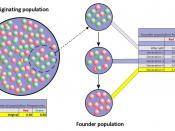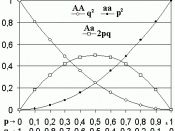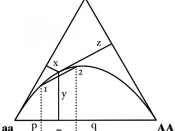Observing Various Microevolution Cases using Population Genetics:
Using a Population Gene Pool Simulator, PopCycle
Abstract
The study of microevolution was tested in this laboratory experiment through the examination, observation, and analysis of various population conditions, some under the Hardy-Weinberg Theory of Genetic Equilibrium, which would advance the student scientists' understanding of both microevolution and the mathematical aspects of microevolution known as population genetics. The students first predicted the result of each of the 6 cases. The data was found using a program called PopCycle (Herron 2002), which picked genotypes randomly, and showed the results after particular conditions were entered. Students took these numbers and visually displayed them in charts. They configured the predicted amount of adults for each genotype by using the Hardy-Weinberg mathematical equation p2 + 2pq + q2 to figure out the expected adults for the genotypes AA, Aa, and aa. The students also produced graphs showing allelic frequencies and genotype frequencies.
They concluded that their original hypotheses were indeed correct. Therefore, there was support that the Hardy-Weinberg Theory and the 5 cases for evolution were indeed accurate in their own particular cases (170 words).
Introduction
In this report, students conduct a laboratory procedure that exemplifies certain occurrences of genetics among populations. In other words, the students predict and observe the results in a population from generation-to-generation due to certain specific conditions, also known as a study called microevolution (Pearson Education, Inc. 2002). In some cases, evidence supports evolution. Evolution is defined as the changes that have transformed life on Earth from its earliest beginnings to the diversity that characterizes it today (Pearson Education, Inc. 2002). There are five known cases for evolution, known as selection, migration, non-random mating, genetic drift, and mutations. Selection is best described by the alteration of survival rates. For example, if a...


